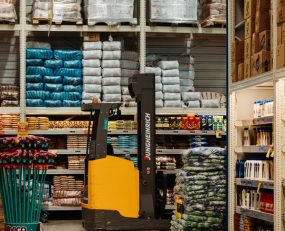
Global vacancy rates in warehouses are currently at record lows. Throughout Q1 of 2022, vacancy rates in the US averaged 3.2% and 3.3% in Europe according to Prologis and Savills, respectively. In developed areas in Asia Pacific, such as Seoul and Tokyo, vacancy rates are averaging less than 3% vacancy rates according to CBRE. This is coupled with growing rental rates globally for occupiers in warehouses, as well as increases in wage demands from warehouse labourers. Growing rent is especially prominent in developed urban areas; London prime rents for example have increased by 20% year-on-year (y-o-y) in 2021 according to Colliers.
A key driver of change is the e-commerce market, which has seen rapid growth since the beginning of the COVID pandemic. According to Morgan Stanley, global e-commerce rose from 15% of total retail sales in 2019 to 21% in 2021, now sitting at an estimated 22% of sales in 2022. Morgan Stanley believes the global e-commerce market could increase from $3.3tn in 2022 to $5.4tn in 2026. Some countries are growing faster than others, such as the US, where Forbes found that e-commerce has grown 50.5% from 2019 to February 2022.
With e-commerce, consumer demand requires next-day delivery for companies to remain competitive in the market. It is therefore advantageous for retailers that goods are stored close to customers in urban areas. However, urban areas contain the most expensive land prices. A solution for this could be the development of multi-storey warehouses to make use of the limited land available, whilst also being more cost-effective. This close proximity can also save costs, as CBRE states that transportation costs account for an average of 50% of the total costs for logistics operations.
Multi-storey warehouses are facilities built vertically with truck ramps and docks located on multiple floors. Floors above the ground floor are typically serviced by ramps, freight lifts, or conveyor systems. Ramps allow small trucks to access the different floors for loading and unloading cargo. The access bays for loading and unloading of goods mean that each level can operate independently. These warehouses can be built with floors without such access, though these floors will then only be suitable for the storage of goods.
JLL states multi-storey warehouses have existed in the Asia Pacific region for decades, particularly in the more developed markets of Japan, South Korea, Singapore, and Hong Kong, due to dense populations and limited land availability. According to Carter Jonas, the warehouses are typically up to three storeys, but can reach higher, with the largest located in Hong Kong which is as tall as a 22-storey building.
Australia is predicted to increase its portfolio of multi-storey warehouses in South Sydney, to tackle its low vacancy rates, high rent, and increasing land prices. As CBRE has found in 2021, only 5% of total industrial zoned land in Sydney is underdeveloped, which will further increase land prices due to the limited supply. CBRE states that around 351,026 sq m of multi-storey floorspace is predicted to be completed between 2022 and 2026, with 14 total projects in Sydney.
Australia isn’t the only place trending towards multi-storey warehouses, with the US also following suit. Prologis claims it built the first US multi-storey warehouse in Seattle in November 2018, at three-storeys and 590,000 sq ft, with Prologis planning on another three-storey project in San Francisco. However, according to James Breeze, senior director, and global head of industrial and logistics research with CBRE, New York has the most multi-storey industrial projects in the country. New York has further multi-storey warehouses planned, such as Australian REIT the Goodman Group paying nearly $130m for a 3.2-acre site on Northern Boulevard in Queens, which it plans to turn into a multi-storey warehouse. Other multi-story projects under development or in planning include the $381m, 1.3m sq ft Bronx Logistics Center, the 1.1m sq ft Grand Logistics Center in Queens and an 840,000 sq ft two-storey warehouse project in the Bronx by a joint venture of Innovo Property Group and Square Mile Capital Management.
Elsewhere, multi-storey warehouses can be found in multiple countries, such as SEGRO multi-storey warehousing projects in Europe. In Paris, SEGRO built a 50,000 sq m multi-storey warehouse in Port de Gennervilliers for Ikea. SEGRO also owns a multi-storey warehouse in the UK, with a two-storey 234,000 sq ft warehouse near Heathrow.
However, multi-storey warehouses also have its own limitation which can hinder its growth and stop companies from creating these facilities. For example, multi-storey facilities are expensive to create. Prologis stated that under new building codes in the US, if a structure is more than three stories in height a one-hour fire rating is required, meaning the structure will resist exposure to fire for one hour. Because of this regulation, developers need to create buildings capable of meeting this, such as the use of heavy steel or warehouses made of concrete, with the use of either adding to the cost of construction. Also, multi-storey facilities need elevators, ramps, equipment rooms and more to make use of each floor, this then lowers the percentage of floor space available to rent out, with the average rentable space at 75%. Similarly, Carter Jones states that facilities in urban areas may not have the road layouts suitable for the volume of lorry traffic necessary to fully optimise multi-storey warehouses in certain urban areas.
Overall, multi-storey warehouses have the potential for further development globally, with e-commerce continuing to rise and the demand for last-mile delivery to reach consumers as fast as possible, the potential is clear. However, its use may be specific to certain cities where land is scarce or expensive, and the roads are suitable to support a multi-storey operation.
Source: Transport Intelligence, July 5, 2022
Author: Michael Sinclair